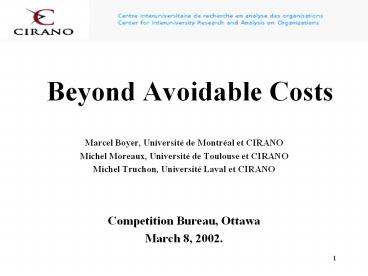Beyond Avoidable Costs - PowerPoint PPT Presentation
Title:
Beyond Avoidable Costs
Description:
Beyond Avoidable Costs Marcel Boyer, Universit de Montr al et CIRANO Michel Moreaux, Universit de Toulouse et CIRANO Michel Truchon, Universit Laval et CIRANO – PowerPoint PPT presentation
Number of Views:61
Avg rating:3.0/5.0
Title: Beyond Avoidable Costs
1
Beyond Avoidable Costs
- Marcel Boyer, Université de Montréal et CIRANO
- Michel Moreaux, Université de Toulouse et CIRANO
- Michel Truchon, Université Laval et CIRANO
- Competition Bureau, Ottawa
- March 8, 2002.
2
I. The economic foundations of the notion
of avoidable costs.II. The practical
applicability III. The economics of
cost-sharingIV. Properties of the main
methodsV. Competition policy implications
3
The standard case
- Increasing marginal cost
- Pure competition equilibrium
- and efficiency rule pmc
- pltmc to develop and exercise
- market power
- Competition law and policy to control the
- development and exercise of market power
4
The non-standard cases
- Fixed cost and constant marginal cost
- Economies of scale and scope (decreasing
marginal cost) - Natural monopolies
- Network economies
5
The non-standard solutions
- First-best pmc and a subsidy
6
The non-standard solutions
- First-best pmc and a subsidy
- Budget constraint (no subsidy)
second-best Ramsey-Boiteux
pricing based on the inverse
elasticity rule
7
The non-standard solutions
- First-best pmc and a subsidy
- Budget constraint (no subsidy)
second-best Ramsey-Boiteux
pricing based on the inverse
elasticity rule - X-inefficiencies and information
asymmetries
8
The non-standard solutions
- First-best pmc and a subsidy
- Budget constraint (no subsidy)
second-best Ramsey-Boiteux
pricing based on the inverse
elasticity rule - X-inefficiencies and information
asymmetries - Competition-based policy to control
anti-competitive behavior
9
Competition-based controlThe Competition law
- To solve the standard cases
- To solve the non-standard cases
10
Competition-based controlThe Competition law
- To solve the standard cases
- To solve the non-standard cases
- In non-standard cases,
- the competition-based control
- may appear to implement a non-efficient
solution
11
Competition-based controlThe Competition law
- To solve the standard cases
- To solve the non-standard cases
- In non-standard cases,
- the competition-based control
- may appear to implement a non-efficient
solution - The cost-sharing approach
- Cooperative game between stakeholders
- All costs are shared
- Second-best or Third-best approach
12
Beyond avoidable coststhe cost-sharing approach
- Customers as stakeholders in recovering costs
- (classes and coalitions)
- Think in terms of properties (axioms)
- Develop a method to share costs
- From prices to cost-sharing payments
13
Some non-standard examples
- Underground infrastructures
- Pacific Bell vs. Cable operators
- CCT public-private competition
- Airline competition
- Shared computing facilities
14
Shapley-Shubik (SS) cost-sharing rule
- Generalizes the notion of avoidable costs and
- incremental costs
- In non-standard framework, the incremental cost
of a good or facility depends on the rank at
which the good of facility is introduced - But the sequence (rank) is arbitrary
- SS takes the average incremental costs obtained
- over all possible rankings
15
Properties of the SS cost-sharing rule (1)
- Symmetry or Anonymity
- Invariance of the cost shares to the elimination
of dummies - Invariance of the cost shares to the
decomposition of total cost
into specific and joint costs - Demand monotonicity
- Cross demand monotonicity
- The Core property or the stand alone test
- Additivity and Ordinality
16
Properties of the SS cost-sharing rule (2)
- It is the only cost-sharing rule that satisfies
the properties - Symmetry or Anonymity
- Dummy
- Additivity and Ordinality
- It is a costless surrogate for the allocation
that would be obtained through bargaining
17
Serial cost-sharing rule (1)
- Generalizes the notion of price
- Equal treatment of equals
- The Serial Principle The benefit and the cost
generated by a large consumption/use should
accrue to that customer (no advantage and no
burden for the smaller users)
18
Serial cost-sharing rule (2)
- Stakeholders demands are ordered from the
smallest to the largest (in quantity or in cost) - All customers of the smallest demand
level (good, segment/facility, equivalent cost)
share its cost
equally - All customers of the second smallest demand level
(good, segment/facility, equivalent cost)
share its incremental
cost equally - And so on till the largest demand is covered.
19
Properties of the Serial rule
- It is the only cost-sharing rule that satisfies
- the Equal treatment of equals
- and the Serial Principle
The benefit and the cost generated by larger
customers accrue to those customers (no advantage
and no burden for the smaller users)
20
The applicability of cost-sharing rules
- Data
- Computer programs
21
Implications for Competition Policy
- Pacific Bell vs. Cable operators
- CCT public-private competition
- Airline competition
- Shared computing facilities
- competition between providers (outsourcing)
- The future more and more cases ?































